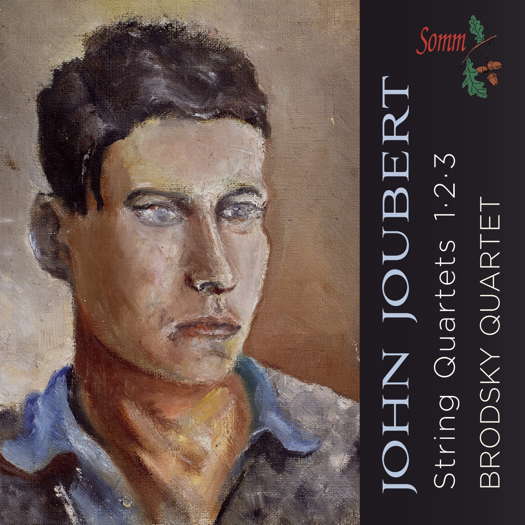
A Fascinating Recording
John Joubert's
string quartets -
heard by
ALICE McVEIGH'The Brodskys throw themselves into the lament for Shostakovich ...'
|

|
This is a fascinating recording of three works spanning the creative lifetime of this composer.
There is something aspirational and even Brahmsian about the first subject of Joubert's youthfully exuberant first quartet, though rhythmic figures soon intervene. A nagging dotted motive propels the first movement into a sense of increasing tension. The Brodsky's instinctive ability to project individual lines within a complex framework is wonderfully clarifying here, though Joubert's melodic feel wars with the more destructive energies to the end.
Listen -- John Joubert: Allegro non troppo (Quartet No 1)
(track 1, 4:12-5:20) © 2012 Somm Recordings:
The extraordinary second movement features a luscious oration from Paul Cassidy on viola, which is later overtaken by Daniel Rowland (leader). There is a sense of youthful yearning throughout, a sense of feelings being expressed but not necessarily requited. An astonishing work to have been composed while Joubert was still at the Royal Academy of Music.
Listen -- John Joubert: Lento (Quartet No 1)
(track 2, 0:00-1:22) © 2012 Somm Recordings:
Dissonances revolve within the dance of the two instruments (especially) and there is featured an eerily lovely section of the violin in its highest tessitura and the viola answering in its normal range, but with equal emotional intensity. The second violin and cello become caught up in the struggle, but the movement ends without reconciliation.
The third movement has a puckish drive about the finale, but though clever and even witty, it lacks the emotional charge of the second movement, and is perhaps too influenced by Walton. It works wonderfully but is much more a young man's work than the other movements. The Brodsky deliver with their personal brand of disciplined abandon, which cannot be too highly praised, with a soulful duo (this time featuring Rowland's rich-toned violin and Jacqueline Thomas' elegant cello) in the middle.
The second quartet was commissioned by the Birmingham Chamber Music Society twenty-seven years later. Joubert describes it as being influenced not only (again) by his wife, but by Beethoven's 'Muss es Sein' of Op 135, which is quoted, elaborated and disputed in the first movement, wrestled into the major in the second movement, used as a lament for the recent death of Shostokovich in the third and reconciled in the fourth (in which Joubert was also inspired by the title of D H Lawrence's collection of verse 'Look! We have come through!').
Listen -- John Joubert: Allegretto (Quartet No 2)
(track 7, 3:58-5:10) © 2012 Somm Recordings:
Although the quartet shares some textural and harmonic language with the first, the overall greater depth of passion and power is obvious throughout this work. The fifty-year-old Joubert has learned how to trust his own voice entirely. The second movement features some stunning glissandi and dissonances as well as the clever contrapuntal work in which Joubert and the Brodsky equally excel. Occasionally I found the viola sound underpowered, a flaw in the recording perhaps? It was never emotionally underpowered, but slightly less favoured acoustically than (especially) the violins.
For me, the third movement is the gem of the recording. The Brodskys throw themselves into the lament for Shostakovich without once losing the momentum of what is a rhetorical outburst, a lyrical intermission only tempered by two feverish sections, which are immaculately dispatched. The mood is at times impassioned to the point of fury, at times mired in regret, especially the quotation from Shostakovich in the viola.
Listen -- John Joubert: Adagio (in memoriam DSCH) (Quartet No 2)
(track 6, 7:13-8:03) © 2012 Somm Recordings:
Sunlight emerges in the attacca fourth movement, but remains undercut for me by the lingering resonance of the third. Unsure whether the Lawrentian serenity truly has the final word, but a true masterpiece all the same.
Ten years separate the second and third quartets (the third being a BBC commission) and Joubert's new freedom (early retirement) is evidenced by more abstract concepts and less fugal writing. The Brodsky ingeniously maintain the charged momentum of the first movement, and the jagged sections never become dogged. The soft timbre of Rowland's DSCH motive gives way to a final push to the close, and the music slips away with only the cello still mid-flight.
Listen -- John Joubert: Allegro con fuoco (Quartet No 3)
(track 8, 5:00-6:21) © 2012 Somm Recordings:
The second movement is fugal, paced just this side of funereal by the Brodskys, with dotted-rhythm features. The violins occasionally slip into a mood of more hesitant, reminiscent character, but the broodingly intense threat never quite disappears.
The last movement (attacca) is more dancelike, and softer-hued, with a Ravel influence due to the enthusiasm of the work's dedicatee and Joubert's teacher, Howard Ferguson. This manifests itself not only in tremolo, impressionistic effects but in a less dense flavour and moments of cool wit.
Copyright © 7 July 2012
Alice McVeigh,
Kent UK

| 
